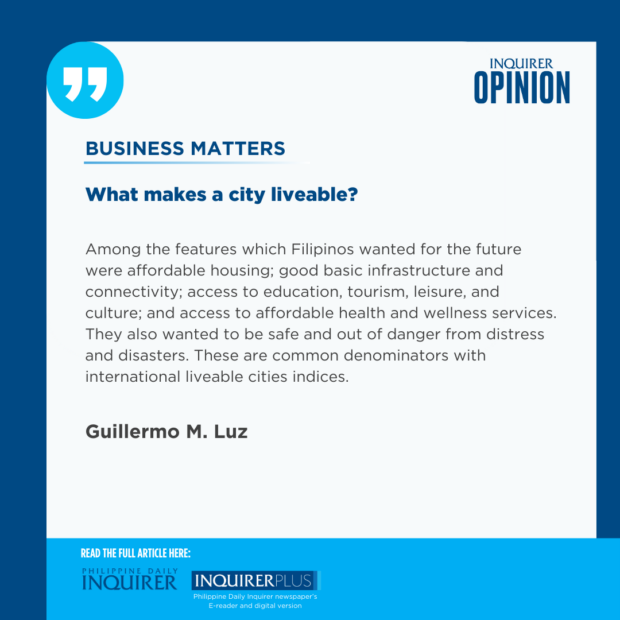What makes a city liveable?

What makes a city “liveable”? This is a question we’re often asked at the Liveable Cities project we run. Liveability can be a subjective matter for some—what you like about a particular city, for instance. However, there are actually some common standards which people use to evaluate whether a city is “liveable.”
Two reports came out recently on city rankings on a global scale. The first was the Oxford Global Economics Global Cities Index 2024 and the second is the 2024 Global Liveability Index by the Economist Intelligence Unit (EIU), a sister organization to The Economist magazine. Both measure cities in a slightly different way but are instructive in what it tells us about what features or characteristics matter in cities.
We share the same view as what Oxford Economics and other organizations think about cities. “Cities are the driving force behind our global economy. They are the engines for national economic growth, centers for education and innovation, and seats of government power,” according to Oxford Economics.
Their report tracks the Top 1,000 cities in the world in terms of economics, human capital, quality of life, environment, and governance. These five categories measure the attractiveness of cities to residents and investors. These 1,000 cities represent 30 percent of the world’s population but 60 percent of global gross domestic product (GDP). Interestingly, 70 percent of these cities outperformed their own countries in GDP and employment growth in the decade before COVID-19 struck. This trend was consistent across countries regardless of their income levels. Cities in rich and poor countries tended to outperform their own countries. Not surprisingly, they also had more educated populations and better access to basic services.
East Asia led the way with most cities in the Top 1,000 with 205, followed by Western Europe (141), South Asia (137), Eastern Europe and Central Asia (107), North America (103), South America (63), Middle East and North Africa (62), Central America and the Caribbean (46), and Oceania (12). The Philippines had nine on the list.
The Top 10 on the list were New York (1), London (2), San Jose, California (3), Tokyo (4), Paris (5), Seattle (6), Los Angeles (7), San Francisco (8), Melbourne (9), and Zurich (10).
The nine cities for the Philippines were Manila (256), Cebu (436), Cagayan de Oro (487), Davao (500), Angeles (502), Bacolod (538), Dagupan (604), Zamboanga (695), and General Santos City (723). It’s not clear whether Manila referred to the city or to the entire Metro Manila.
The EIU’s world’s most liveable cities list for 2024 measures liveability in terms of such features as stability, health care, culture, environment, education, and infrastructure. Stability includes items like social unrest, crime and gun control laws, and conflict. Infrastructure includes measures on housing availability and prices. Basically, EIU’s index is a measurement of how comfortable it is to live in a city.
For the third consecutive year, Vienna has topped the list, followed by Copenhagen (2), Zurich (3), Melbourne (4), Calgary and Geneva (tied for 5th), Sydney and Vancouver (tied for 7th), and Osaka and Auckland (tied for 9th). Notably, London ranked 45th (versus 2nd on Oxford’s list, Los Angeles was 58th (7th on Oxford’s list), and New York came in at 70th (1st on Oxford’s list). A total of 173 cities appeared on the list. Metro Manila ranked 136th in the 2023 report.
For the Philippines, we can look at the AmBisyon Natin 2040 vision to give us some hints at what Filipinos might be looking for in cities—in fact, across our entire society in general and not limiting the wants to cities. AmBisyon was a 25-year aspirational plan launched in 2015 and designed to span four administrations for continuity in national planning. Among other things, it surveyed 20,000 Filipinos from all walks of life across the country to ask them what their aspirations and ambitions were for themselves and the country.
Among the features which Filipinos wanted for the future were affordable housing; good basic infrastructure and connectivity; access to education, tourism, leisure, and culture; and access to affordable health and wellness services. They also wanted to be safe and out of danger from distress and disasters. These are common denominators with international liveable cities indices. Mayors who focus on providing these and other factors such as those found in the Oxford and EIU lists would be doing a great service for their own residents and make their cities more attractive for investors as well.
Guillermo M. Luz is chair of Liveable Cities Philippines and chief resilience officer of Philippine Disaster Resilience Foundation.
Business Matters is a project of Makati Business Club (makatibusinessclub@mbc.com.ph).




















